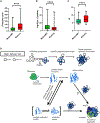NGLY1 mutations cause protein aggregation in human neurons
- PMID: 38039131
- PMCID: PMC10826878
- DOI: 10.1016/j.celrep.2023.113466
NGLY1 mutations cause protein aggregation in human neurons
Abstract
Biallelic mutations in the gene that encodes the enzyme N-glycanase 1 (NGLY1) cause a rare disease with multi-symptomatic features including developmental delay, intellectual disability, neuropathy, and seizures. NGLY1's activity in human neural cells is currently not well understood. To understand how NGLY1 gene loss leads to the specific phenotypes of NGLY1 deficiency, we employed direct conversion of NGLY1 patient-derived induced pluripotent stem cells (iPSCs) to functional cortical neurons. Transcriptomic, proteomic, and functional studies of iPSC-derived neurons lacking NGLY1 function revealed several major cellular processes that were altered, including protein aggregate-clearing functionality, mitochondrial homeostasis, and synaptic dysfunctions. These phenotypes were rescued by introduction of a functional NGLY1 gene and were observed in iPSC-derived mature neurons but not astrocytes. Finally, laser capture microscopy followed by mass spectrometry provided detailed characterization of the composition of protein aggregates specific to NGLY1-deficient neurons. Future studies will harness this knowledge for therapeutic development.
Keywords: CP: Neuroscience; NGLY1 deficiency; chaperones; fragmented mitochondria; neural cells; organoids; protein aggregates.
Copyright © 2023 The Authors. Published by Elsevier Inc. All rights reserved.
Conflict of interest statement
Declaration of interests The authors declare no competing interests.
Figures







References
-
- Huang C, Harada Y, Hosomi A, Masahara-Negishi Y, Seino J, Fujihira H, Funakoshi Y, Suzuki T, Dohmae N, and Suzuki T. (2015). Endo-β-N-acetylglucosaminidase forms N-GlcNAc protein aggregates during ER-associated degradation in Ngly1-defective cells. Proc. Natl. Acad. Sci. USA 112, 1398–1403. - PMC - PubMed
Publication types
MeSH terms
Substances
Grants and funding
LinkOut - more resources
Full Text Sources
Molecular Biology Databases
Miscellaneous

